George Albert Hodkinson: 1915-1918 – in the army in England
George Albert Hodkinson: 1897-1915 – birth to enlistment
George Albert Hodkinson: 1915-1918 – in the army in England ... this page
George Albert Hodkinson: 1918 – death in France

George Albert Hodkinson: the start of life in the Army.
- Parents: John William Hodkinson and Frances Eliza Hodkinson
- Born: Thursday, 4th November 1897
- Died: Thursday, 22nd August 1918 (age 20 years and 9 months)
George Albert Hodkinson attests for service: Friday, 10th December 1915

Those that attested for military service were issued with an armband which indicated their military status. (Photograph © IWM (INS 7764) reproduced with permission: Imperial War Museum.2)
1914 brought the start of the first global conflict, with carnage on a massive scale. The high number of casualties, alongside other demands for manpower, meant that the British Army increasingly found it difficult to fill its ranks from a shrinking number of volunteers. One of the steps taken by the government was to appoint Lord Derby as Director-General of Recruiting on 11th October 1915. An opponent of conscription, he introduced the so-called Derby Scheme, under which men aged 18 to 40 could enlist voluntarily or attest with an obligation to join when it became necessary. The scheme was introduced on 15th October 1915 and abandoned on 15th December of the same year since it failed to provide enough immediate volunteers
Yet, over two million men attested for later service, a figure that included George Albert Hodkinson1, who attested in Stockport on Friday, 10th December 1915 – less than a week before the scheme was ended. Late attestation was not unusual: conscription was on the horizon and some may have wanted to avoid being classified as conscripts. More importantly, attestation also gave recruits a better chance of choosing the regiment they wanted, although nothing was guaranteed. As it was, Albert was initially allocated his local regiment – the Cheshires. Those that attested were given an armband with a red crown to indicate their military status and were sent home until they were called up.
One aspect of the Derby Scheme was the classification of men into 46 groups related to age and marital status. Albert, aged 18 years and one month, and single, was placed in Group 1. Men in this group were the first to be called up under the Derby Scheme with mobilisation from February 1916 to March 1916. However, many men were late in being called up: Albert was one of them, with his turn coming on Monday, 15th May 1916. He would have been told this date at the start of the month, giving him two weeks to give notice to his employer and to put in order any other matters that needed to be sorted. From 15th May 1915, Albert’s short army career spanned service with four different regiments or corps.
George Albert Hodkinson: from Stockport to Rouen
This map shows the direction of Albert's travels in England, whilst in the army, which eventually took him to Portsmouth from where he embarked for Rouen on the last day of May 1918. The red square marks his start in Stockport.
Red square: Stockport, Albert's home.
Brown square: Kinmel Camp, Abergele, Denbighshire. 15th May 1916 to August 1916. This was Albert's first posting as a member of the 14th (Reserve) Battalion of the Cheshire Regiment.
Orange square: Prees Heath Camp, Whitchurch, Shropshire. Aug 1916 to 1st Sep 1916. This was Albert's second posting as a member of the 14th (Reserve) Battalion of the Cheshire Regiment.
Purple square: Birkenhead. 1st Sep 1916 to 31st Mar 1917. Following reorganisation of reserve infantry battalions, Albert was posted to Birkenhead as a member of the 3rd (Reserve) Battalion of the Cheshire Regiment. Where exactly he was billeted is not known.
Blue square: Prescot. 31st Mar 1917 to 14th April 1917. Albert spent two weeks in Prescot (actual location not known) as a member of the 23rd (Works) Battalion of the King’s (Liverpool Regiment), which was absorbed into the Labour Corps.
Green square: Chester. 14th Apr 1917 to 1st Dec 1917. Albert spent this time as a member of the Labour Corps which included a stay in Chester (exact location not known) as part of the 560th Home Service Employment Company.
Grey square: Park Hall Camp, Oswestry, Shropshire. 1st Nov 1917 to 1st Dec 1917. Whilst still a member of the Labour Corps, Albert spent November 1917 at Park Hall Camp, Oswestry as part of the Western Command Labour Centre.
Pink square: Grove Park, Lewisham. 1st Dec 1917 to Jan 1918. Albert was transferred to the Army Service Corps in December 1917 and he spent about six weeks in his first ASC posting in Grove Park, Lewisham.
Light brown square: ASC MT Training Depot, Sydenham. Jan 1918 to May 1918. Albert was posted to this ASC sub-depot in mid-January 1918. Accommodation was in tents and huts erected in fields and other green places.
Cyan square: ASC MT Training Depot, Osterley Park. May 1918. Albert was part of the training depot at Osterley Park from early May 1918 until he was given leave at Larkhill Camp, Salisbury on 16th May 1918.
Maroon square: Larkhill Camp, Salisbury. 16th May 1918 to 20th May 1918. Albert was given leave here after finishing his training as a driver.
Black square: Bulford Camp, Salisbury. May 1918. Once Albert’s leave in Larkhill Camp was over, he was posted to the Mobilization and Embarkation Area at Bulford Camp.
Yellow square: Portsmouth Harbour. 31st May 1918. This was the day that Albert left England for the first and last time. On 2nd June 1918 he disembarked in Rouen.
George Albert Hodkinson in the Cheshire Regiment: 15th May 1916 to 31st March 1917
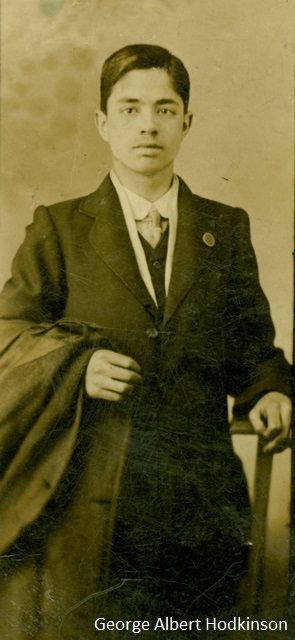
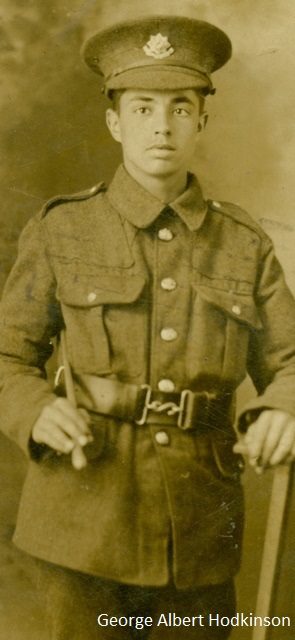
The photographs above show George Albert Hodkinson as a civilian and as a soldier in the Cheshire Regiment. The photographs were taken at van Nelte photographic studios, 8 Princes Street, Stockport, in 1916.
Albert’s first regiment was the Cheshire Regiment. He was initially posted, on Monday, 15th May 1916, to the 14th (Reserve) Battalion with the army number 36881. This battalion had been formed in 1914 in Birkenhead, but moved in July 1915 to the biggest army camp in Wales, at Kinmel, Flintshire. Albert would have made his way there by train, with the last leg being a steep three-mile line which joined the Camp to the London and North Western Railway at Foryd Junction. It was at this camp that Albert completed his basic training with the routine heavy emphasis on discipline, drill, basic field craft and weapon training.
However, Albert’s time at Kinmel was short-lived. In August 1916 his battalion moved to Prees Heath, Shropshire, a new camp established as a training base for trench warfare, with a capacity of 30,000 men.
A few weeks later Albert was on the move yet again. On Friday, 1st September 1916, he made his way to Birkenhead to join the 3rd (Reserve) Battalion of the Cheshires. His posting in Prees Heath had come to an end because the 14th (Reserve) of the Cheshire Regiment disappeared in the light of a huge reorganisation of the reserve infantry battalions. The 3rd (Reserve) Battalion undertook duties which centred on guarding the docks at Birkenhead and Liverpool and the occupation of strategic positions in the Wirral and on Hilbre Island.
The 3rd (Reserve) Battalion was also the battalion which Albert’s dad, John William Hodkinson, joined almost two years earlier (in October 1914), but he was discharged after six months on medical grounds.
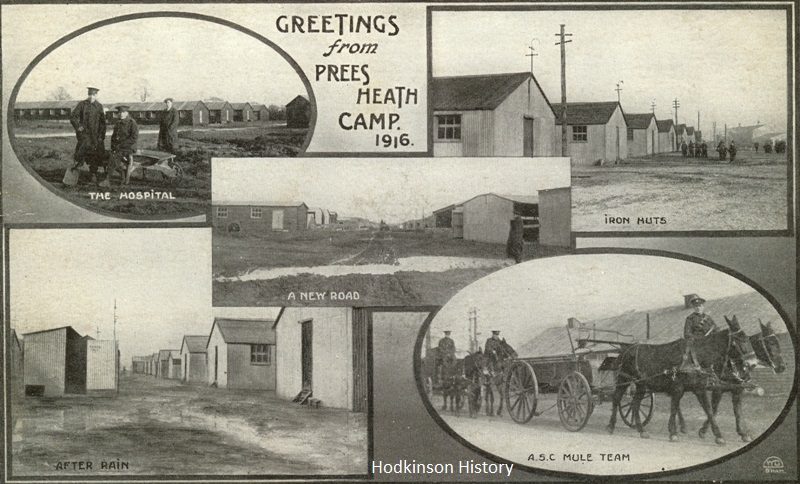
In terms of views, there was not much to recommend Prees Heath Camp in 1916, but somebody must have made some money out of selling postcards of the camp. This is the place where George Albert Hodkinson spent about a month in that year. (Postcard: property of Samuel Hodkinson.)
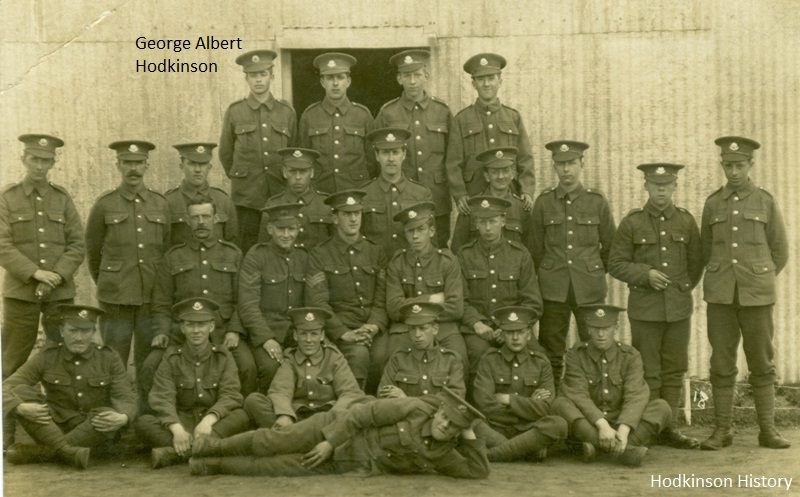
Outside one of the iron huts at Prees Heath, George Albert Hodkinson (top left) poses with his comrades. How many of these 25 soldiers survived the war? (Postcard: property of Samuel Hodkinson.)
Albert's time at Birkenhead was notable in his army career because it was his longest stay in one place: from September 1916 to, it appears, October 1917, albeit with different army units. During this time, Britain experienced one of the worst winters in the twentieth century with heavy snowfalls in many parts of the country. During this time, Albert also celebrated his nineteenth birthday and maybe spent his first Christmas away from home.
Providing accommodation for troops was a major headache for the army and many soldiers were billeted in private residencies. This was the case with Albert who was billeted at 315 Old Chester Road, Birkenhead. He certainly was there in September 1917, but he may well have lived at the same address for the entire duration of his stay in Birkenhead.
During this spell with the Cheshire Regiment, Albert’s fitness levels continued to be assessed. His army medical report of Monday, 15th May 1916 (the day that Albert was mobilised) states him to have "good" physical development. His weight was 9 stones 12 pounds which is, by modern height-weight charts, somewhat on the low side (but not under) for his height of 5 feet 8 inches. However, his height was about one inch more than the average male height at the time.
Fortunately, Birkenhead wasn't too far from Stockport, which meant visits by family members could be made quite easily. However, travelling times on an overstretched railway network would have been much longer than normal. In 1937, his younger brother Steven, on travelling to Birkenhead, would write in his diary that it was twenty years since he was last there.
Despite all this, it was felt that that Albert’s fitness level for fighting was unsuitable and the photographs of him in the Cheshire Regiment do show him to be of a slight build. Perhaps his "good" physical development turned out to be not as good as originally stated or perhaps the initial assessment was accurate, but he was unable to meet the demands and expectations of physical training programmes.
Whatever the reason, Albert’s time with the Cheshires was over.

This is the cap badge of the Cheshires, which must have been something of a challenge to keep clean and brightly polished — an inspecting officer's dream object to scrutinise for the slightest speck of dirt!
Albert had two different regiment numbers whilst with the Cheshires: 36881 and 203485.
George Albert Hodkinson in the King's (Liverpool Regiment): 31st March 1917 to 14th April 1917
Albert now joined his second regiment for just two weeks, becoming part of the 23rd (Works) Battalion of the King’s (Liverpool Regiment), formed in May and June in 1916 at Prescot.
The 23rd (Works) Battalion was one of nine infantry battalions formed by April 1917 for labouring work from those graded medically not fit enough to fight but fit enough to serve abroad. Starling and Lee comment in No Labour, No Battle that men in these battalions were among the lowest medical category capable of serving in the Army.3
How Albert felt about this transfer is hard to say. The age range of those in labour battalions, as Starling and Lee point out, was "often nearer 40 than 30 years of age"4, so Albert’s comrades were likely to have been, on average, over 20 years older than he was. In terms of fighting, there would be no trench warfare as experienced by those infantry soldiers deemed to be fit enough to fight. Yet being in a labour battalion was no guarantee of safety – once abroad soldiers might well be working within range of enemy fire and could be subject to enemy gas and aerial attacks away from the front line. Albert would also have been acutely aware that his battalion and the other labour battalions had low standing in an Army where hierarchy and status were extremely important (and still are!)
Albert, however, had little time to get used to being a soldier in the King's (Liverpool Regiment). After only two weeks he was transferred to the Labour Corps.
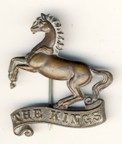
This is the cap badge of the King's (Liverpool Regiment). Albert kept his number from the Cheshires – 203485 – whilst with this regiment.
George Albert Hodkinson in the Labour Corps: 14th April 1917 to 1st December 1917

This is a view of just part of the camp at Oswestry where Albert spent four weeks during the autumn of 1917.
The increasing demand for soldiers to maintain and develop the diverse infrastructures that were essential for the war effort led to the formation in January 1917 of the Labour Corps. It grew in size to almost 400,000 men by early 1918, absorbing seven of the nine labour battalions in the process. This included Albert’s 23rd (Works) Battalion of the King’s (Liverpool Regiment), which became the 1st Battalion of the Labour Corps in April 1917.
Those in the Labour Corps were medically assessed on a regular basis. Medical categories had been reclassified in June 1916. Grade "C" at that point indicated that the soldier was fit for home service only, but from January 1917 men with sub-categories of "Ci" or "Cii" could now be posted overseas. In June 1917, Travelling Medical Board (TMB) No.7 classified Albert as "Ci" with the comment that he was "likely to be fit." The "i"sub-category determined that soldiers were suitable for duties with a garrison or provisional unit.
At the start of August 1917, TMB No.7 again assessed George Albert Hodkinson and down-graded him to "Cii". Those with this category could have duties with Labour units or outdoor employment with a garrison or regiment. The physical requirements for a "Cii" were that a man should be able to walk to and from work for a distance of not more than five miles and have hearing and sight that was sufficient for ordinary purposes.
A re-organisation of the Labour Corps from May 1917 to June 1917 led to the creation of a number of Home Service (HS) Employment Companies. Albert became a member of the 560th HS Employment Company, stationed in Chester. Starling and Lee comment that these companies consisted of men of the lowest possible medical categories so that those fitter could be posted overseas.5
However, Albert was soon on the move again: on Thursday, 1st November 1917, he was posted to the Western Command Labour Centre (one of eight Labour Centres which covered Britain and Ireland) at Park Hall Camp, Oswestry. During the time that Albert was in the Labour Corps, his dad, John William Hodkinson, joined the army for a second time. This time his service was with the Royal Engineers from May 1917 to October 1917. Once again, he was discharged from the army on medical grounds.
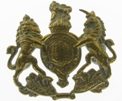
This cap badge (the Royal Coat of Arms) was the General Service badge and worn by those in the Labour Corps until they were allocated their own badge in 1918.
George Albert Hodkinson in the Army Service Corps (ASC): 1st December 1917 to 22nd August 1918
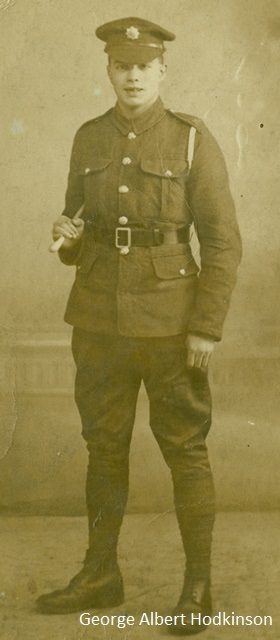
Whilst at the Western Command Labour Centre at Oswestry, a separate note was made on Albert’s record of his civilian occupation as an iron turner and, in the same sentence, of his transfer to a Mechanical Transport (M.T.) Company of the Army Service Corps. Perhaps this juxtaposition was unintentional or perhaps it was felt that a soldier with skills as an iron turner was a suitable candidate for what would be driver training!
Albert's transfer from the Labour Corps to the Army Service Corps (ASC) took place on the first day of December in 1917. He was joining a corps which was performing vital functions in moving stores and undertaking a huge variety of support services. At its peak, the ASC had over 10,500 officers and 315,000 men who were the "the unsung heroes of the British Army in the Great War."6
Like so many who joined the army, Albert had never travelled far from his home town. Once in the army, geographical horizons were broadened. So far, he had been based in his home county of Cheshire or in the adjoining counties of Lancashire, Flintshire and Shropshire; now he was well and truly on the move. He would spend time in London and Salisbury, before making the journey to Rouen and other locations in France. The first stop in southern England was Grove Park ASC Reserve Depot in Lewisham, London.
George Albert Hodkinson is pictured as a member of the ASC. The cap badge shown is of the Army Service Corps with its motto of 'Honi soit qui mal y pense.' (Shame on him who thinks this evil.)
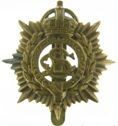
ASC No. 1 Reserve MT Depot: Grove Park, Lewisham, London
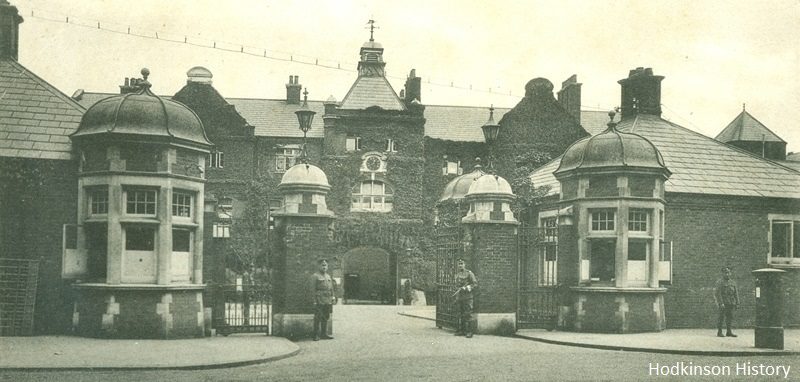
This view, from a postcard from the Great War, shows the entrance to Grove Park Depot – a sight that Albert Hodkinson would have been very familiar with. Albert Hodkinson was one of almost 300,000 personnel who passed through the depot between 1914 and 1919. However, he did not pass through the main gate which was the entrance for officers.7 (Postcard: property of Samuel Hodkinson.)
Albert spent about six weeks at Grove Park, arriving at the start of December 1917, spending Christmas and New Year there, and leaving in mid-January 1918. The buildings of Grove Park were used for officer accommodation. Other ranks had to make do with tents in and around the grounds.
The official start of Albert's own training began on 4th December 1917, when Albert received his Army Service Corps Certificate of Trade Proficiency which stated him to be a "Learner Driver". It wouldn't be too long, however, before Albert would be driving Army vehicles through the streets of central London.
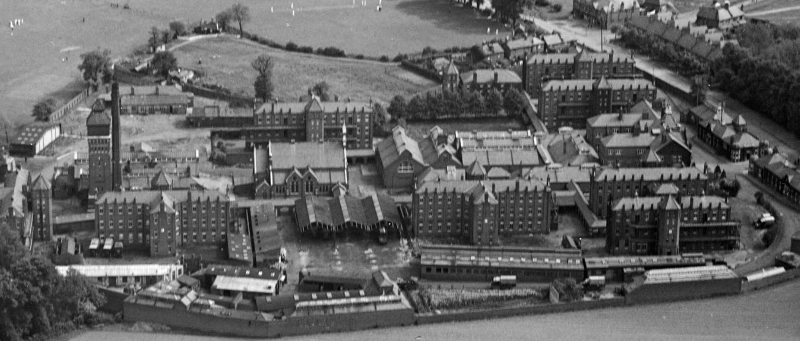
This 1921 photograph shows the extensive buildings at Grove Park. Grove Park began life in the first years of the twentieth century as a Greenwich workhouse. At the outbreak of the Great War, it was taken over by the Army Service Corps as a mobilisation and training centre. The entrance as seen on the postcard view above was to be found on the road on the right of the photograph. The large tower on the left is a water tower. Modern housing now occupies virtually all of the site. (The photograph is reproduced from Britain from Above.8)
ASC MT Training Depot: Sydenham
Despite the huge numbers catered for by Grove Park, the depot was not big enough to cope with the demands placed upon it. Consequently, other locations were taken over and a number of sub-depots were established including one in Sydenham and one in Osterley Park. In ASC sub-depots, the soldiers were accommodated in tents and huts erected in fields and other green places.
Albert spent from mid-January 1918 to the first days of May 1918 in Sydenham. Not too much is known about Albert's time here, except for one important event: a medical examination which graded him as "B ii". A subsequent entry in his records dated 4th April 1918 stated that he was "fit for overseas". This comment brought a stark reality into Albert's life. His training as a driver now took on a different dimension and he would have been aware that it wouldn't be too long before he was the putting skills that he was being taught into practice on the Western Front.
ASC MT Training Depot: Osterley Park
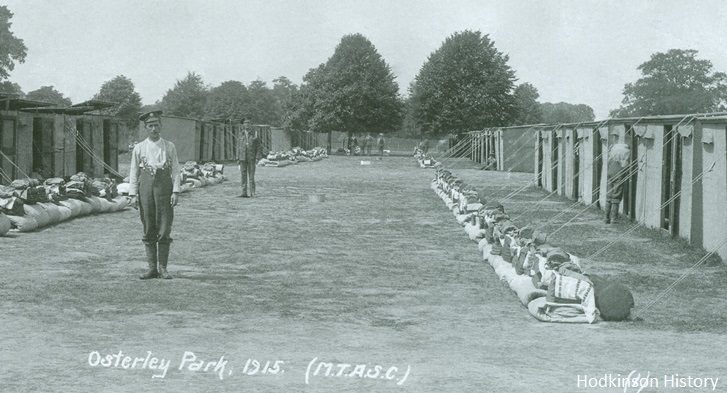
This is a 1915 postcard of Osterley Park showing temporary huts. George Albert Hodkinson spent time at Osterley in May 1918. (Postcard: property of Samuel Hodkinson.)
In early May 1918, Albert joined the ASC Depot at Osterley Park, Isleworth and continued to learn how to drive. Training routes included Marble Arch, Hyde Park Corner, Oxford Circus and Pall Mall. Trainee drivers were not allowed to exceed 8 miles per hour.10
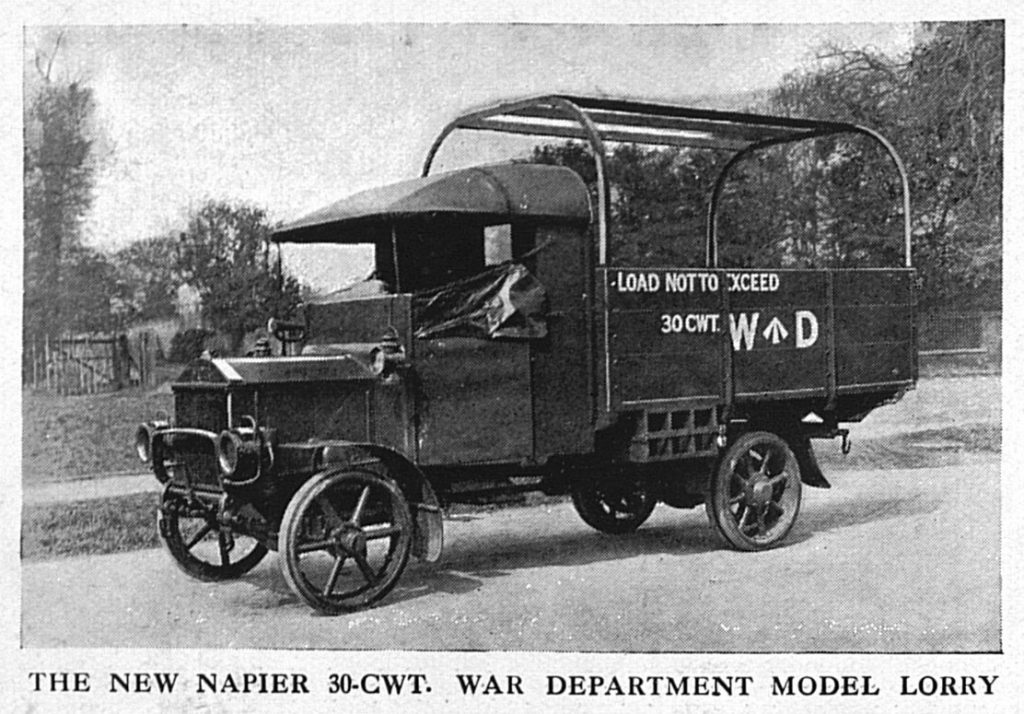
This photograph and caption are from a 1915 edition of the newspaper The Graphic 9 and shows one of the vehicles – a Napier lorry – that Albert Hodkinson was allowed to drive once he had passed his test.
Albert took his driving test on Thursday, 10th May 1918. All testing for trades was graded against six levels of accomplishment: skilled, very good, good, fair, indifferent and bad. As it was, Albert came out reasonably well, being deemed "fair". This meant that he would be able to drive lorries under the makes of Napier, Albion, Pierce Arrow, Daimler and Peerless.
(As an aside, what is interesting about the grading is that there was no "failed" category. It looks – and I have found no answer to this yet – is that those with a "bad" grading could still be drivers, or cooks, or bakers, or shoemakers, and so on, without any kind of extra training. An interesting thought!)
Maybe Albert Hodkinson was pleased to have gained his certificate with a grading that wasn't anything to be ashamed of, or maybe he had hoped for more, but, whatever his feelings, he did have the pleasure of a pay increase which began the following day, a reflection of his newly acquired trade.
Larkhill Camp, Salisbury
With his training over, Albert was given leave from Thursday, 16th May 1918 to Monday, 20th May 1918, at Larkhill Camp in Salisbury.

This view of Larkhill Camp is taken from a postcard from about 1915 and shows a location that has a sense of bleakness and loneliness – a good place to have army leave! (Postcard: property of Samuel Hodkinson.)
Bulford Camp, Salisbury
Following leave, Albert was posted to the MT Mobilization and Embarkation Area at Bulford, Salisbury.
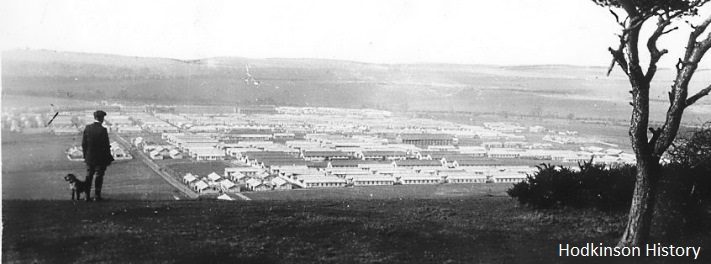
A postcard from the time of the Great War gives an indication of the vastness of the camp, where soldiers from many different regiments and corps could be found. Albert wasn't here for long: by the end of May 1918, he was on his way to France. (Postcard: property of Samuel Hodkinson.)
From Bulford to Portsmouth and then to Rouen
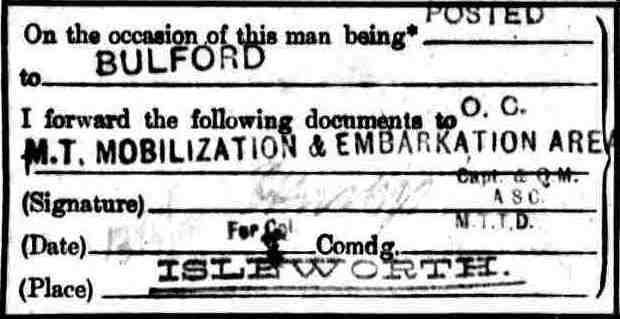
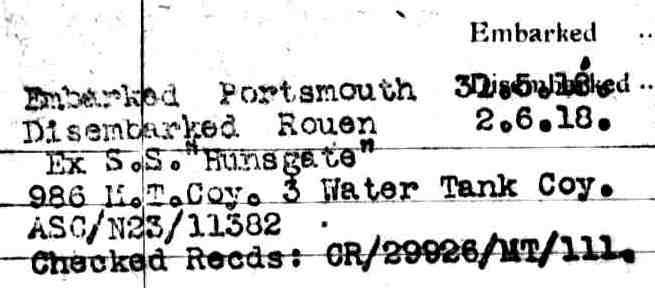
In September 1940, an incendiary bomb set fire to the War Office's record store in London. About two-thirds of soldiers' documents relating to the Great War were destroyed. It is fortunate that Albert's records survived (some with burnt edges, as with the image at the top of this page), providing so much information about his time in the army such as the details above. As an aside, it is interesting how 'mobilization' as on the first image, is now regarded as an American spelling.
On Monday, 27th May 1918 Albert’s company – the 3rd Water Tank Company (986 Motor Transport Company) – left Larkhill for Portsmouth, one of the embarkation ports which the ASC had for its MT sections. The 3rd Water Tank Company was split into two convoys. One left at 4 am and the second left at 6 am: a total of 8 officers, 256 other ranks and all their vehicles. Albert was part of the second convoy.
In Portsmouth, the vehicles were parked at Clarence Barracks. The following day, Tuesday, 28th May, 145 of them were loaded on the SS Hunsgate which was the steam ship that would take the company to Rouen. On Wednesday, the ship left port, with 5 officers, 130 other ranks and their cargo.
The rest of the company, including Albert, now had some time on their hands, waiting for the steamer to return so that the rest of the vehicles and men (3 officers and 126 other ranks) could be loaded. As soon as the ship was back, that task was completed. The ship sailed on Friday, 31st May 1918.
As the Hunsgate steamed slowly away from England towards its destination of a huge Base Depot at Rouen, Albert must have watched the slowly disappearing coastline with a mixture of emotions. His family and his home town of Stockport would have been badly missed. His thoughts may also have been about his army life so far – from that moment that he attested three years previously through to the present day as he stood on the deck of the ship that was taking him to the Western Front. The past and the present may well have been swimming in his thoughts, but thoughts of the future were there too, with the hope and perhaps the confidence that he would return home safely.
The trip had little in the way of comforts and Albert would have recognised much in the following description, written two years earlier by one Francis Smith who spent time on the same boat on a longer journey from somewhere in England to Rouen:
It is really wonderful what they pack into these tramp steamers: we have about 200 lorries & cars besides other stores & she is not half full about 8 ft of the water line showing that causes her to roll…
When you are looking down the hole it is like looking off the roof of our house. The hole is divided into three so you can guess how high we are out of the water. They load up one third & then put a cover on & so on & as they cannot put one lorry on top of another it reduces the load considerably …
They converted the half of the top third of the rear hole into a troop deck, so you can guess it is no class. We have some ASC men on board with us … I don’t what they do, but they get 7/6d a day to drive a lorry …
We have only got 4 small lifeboats on board & 16 life belts between us, on one of the hatches there are 4 crates about the size of a large egg box with a tin tank inside to make it float & some ropes tied to it, the sailors told us they were for the soldiers — if anything happened the boats were for the crew, very considerate don’t you think? 11
The ship had a maximum speed of 9.5 knots which meant that the voyage from Portsmouth to Rouen was slow and dreary, but it passed without incident and everyone safely disembarked on the 2nd June 1918. It wouldn't be too long before Albert was heading for the front line.
George Albert Hodkinson: 1897-1915 – birth to enlistment
George Albert Hodkinson: 1915-1918 – in the army in England ... this page
George Albert Hodkinson: 1918 – death in France
Notes and sources for this page
- Unless otherwise mentioned, this page is based on copies of birth, marriage and death certificates; census returns; and family documents and related items including postcards and photographs which are the property of Samuel Hodkinson.
- Imperial War Museum, IWM Collections. (http://www.iwm.org.uk/collections/item/object/30076979. 10 January 2014.)
- John Starling and Ivor Lee, No Labour, No Battle. (Stroud: Spellmount, The History Press. 2009.) p.4.
- John Starling and Ivor Lee, No Labour, No Battle. (Stroud: Spellmount, The History Press. 2009.) p.4.
- John Starling and Ivor Lee, No Labour, No Battle. (Stroud: Spellmount, The History Press. 2009.) p.51.
- Milverton Associates, The Long, Long Trail. (http://www.1914–1918.net/asc.htm. 14 January 2008.)
- John King, A Short History of Grove Park. (http://www.gpcg.org.uk/?p=groveparkhistory. 14 February 2014.)
- Britain From Above, Grove Park Hospital, Grove Park, 1921. (http://www.britainfromabove.org.uk/image/epw006254. 20 February 2014.)
- The Graphic, Motoring and Aviation. (London. 1 May 1915.) p. 576.
- Michael Young, Army Service Corps. (Barnsley: Leo Cooper. 2000.) p.88.
- Roger Smith, Letter 1015. (www.xvsqnassociation.co.uk/archive/2013_Newsletter.pdf. 3 March 2014.) pp. 12–13.
This page was originally published in May 2009 with the latest revision made on 9th November 2024.
